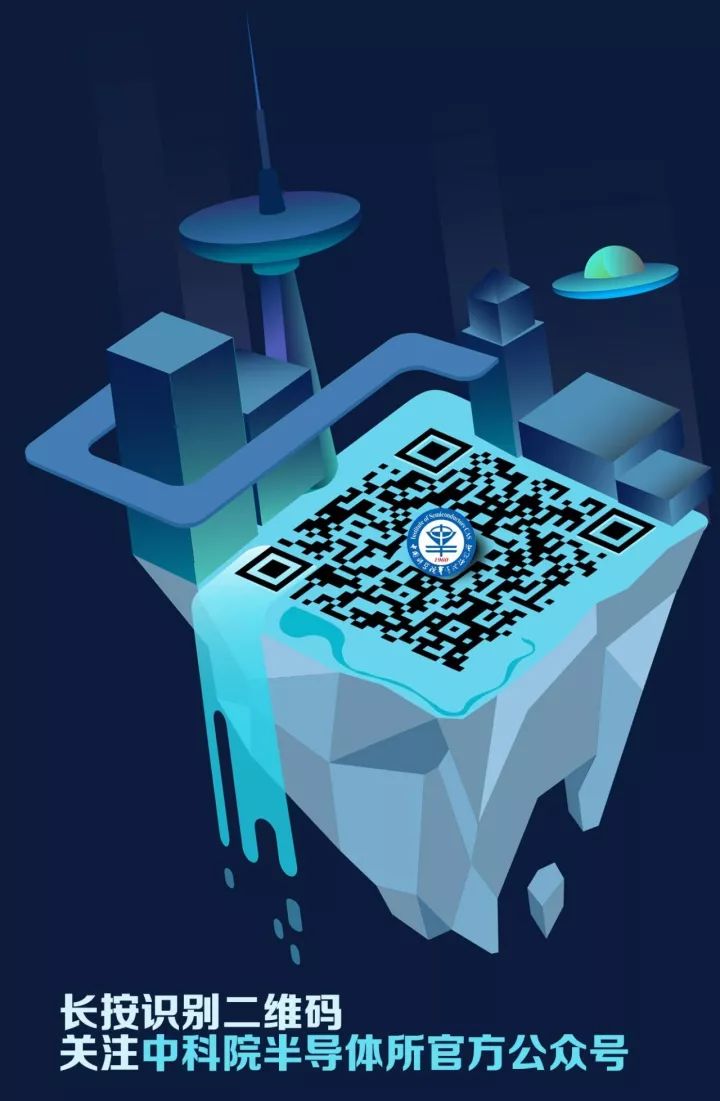
As early as 1982, a group of students from Carnegie Mellon University developed a networked soda machine that could inform users about the stock of drinks in the fridge and whether newly added drinks were cold. This machine is considered the first networked appliance. These students did not realize that their actions would make them pioneers of the Internet of Things (IoT). Currently, the concept of “IoT+” has generated many new terms, such as smart healthcare, smart cities, and smart factories. However, have you ever heard of the combination of “IoT+ operating systems”?
The birth of the IoT operating system (IoT OS) is merely a collision of the two? Clearly, it is not that simple; this matter must be discussed from the perspective of technological development.

In the book “Chronicles of Embedded Operating Systems: Historical Evolution and the Future of IoT” by He Xiaoqing, vice chairman of the Embedded Systems Branch of the China Software Industry Association, the background of the IoT OS’s emergence is mentioned: First, the Internet has built an omnipresent interconnected pipeline for IoT systems, while the development of cloud computing and big data has provided technical support for data processing and analysis in IoT. On the embedded device side, 32-bit MCU technology has matured, and its price is approaching that of 8-bit/16-bit MCUs. It is not only used in gateway devices but is also widely used in sensing and execution units. In the MCU market, the ARM Cortex M series MCUs hold the largest market share. ARM’s complete ecosystem has greatly aided the development of embedded software, including IoT OS.
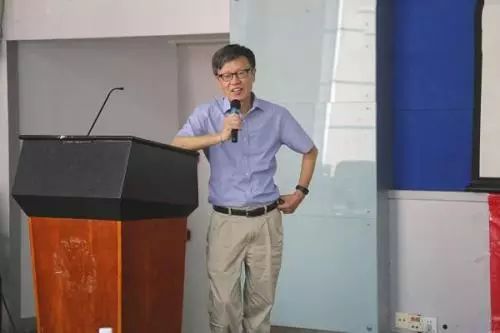
He Xiaoqing, vice chairman of the Embedded Systems Branch of the China Software Industry Association
It can be imagined that the trends of miniaturization, low power consumption, and security on the device side, the flexible conversion between communication protocols, and the application layer’s demand for cloud computing capabilities, as well as the increasingly complex device software, have all become necessary conditions for the emergence of IoT operating systems.
Looking back at history, the first were TinyOS developed by the University of California, Berkeley, and Contiki developed by the Network Systems Group at the Swiss Federal Institute of Technology, both of which were among the earliest sensor OSs with characteristics of IoT OS. In 2010, RIOT (Real-time Operating System) was born in Europe, which could run not only on small MCUs but also supported MPUs.
Until February 2014, at the Embedded World Conference in Nuremberg, Germany, Wind River announced its IoT OS based on VxWorks 7, and subsequently provided product introductions and white papers on its official website. The joining of major operating system companies like Microsoft and Wind River made IoT OS a reality.
From a technological perspective, the kernel technology of IoT operating systems is very close to current embedded operating systems. ARM and Huawei adopt real-time multitasking operating systems, while the kernel of Google Android Things is trimmed from the Android system. He Xiaoqing stated in an interview with reporters from the Nonferrous Network: “The IoT operating system has not created a particularly special kernel but has adopted technologies from embedded operating systems. Currently, this technology can be divided into two types: real-time and general-purpose.”
The term “IoT” has sparked the desire of capital, igniting a war among chip to terminal manufacturers, and has set the battlefield for IoT operating systems ablaze. Domestic and foreign giant enterprises, as well as local “small but beautiful” companies, have all come to the same stage to compete.
The Dawn Before the Battle
“Currently, the products and applications of IoT operating systems are still in the initial exploration and refinement stage. It is estimated that by 2020, several companies’ products will have their technical forms and business models recognized by the industry.” This statement is He Xiaoqing’s judgment on the current era of IoT operating systems.
What products do IoT operating systems in the exploration phase have?
ARM mbedOS
In 2016, Arm was wholly acquired by SoftBank for $32 billion. Its IoT operating system Arm Mbed has developed a strong ecosystem support over the years and, due to the significant influence of the Arm Cortex-M core, the application of Arm Mbed operating system can be easily developed on specific chips.
Just last month, ARM acquired Stream Technologies, a software provider focused on helping businesses optimize their IoT device communication methods. Hima Mukkamala, head of ARM’s IoT cloud services division, detailed some visions for this toolkit in a blog post. He wrote that the acquisition of Stream aims to create an “end-to-end IoT platform for managing, connecting, configuring, and updating devices.” The value positioning of this one-stop shop largely stems from the fact that Stream’s software can almost be compatible with all types of IoT systems and many different types of networks.
In terms of security, Arm also places great importance on it. It has launched the PSA security architecture, which systematically organizes existing security technologies, such as chips and software, to form different security levels; it organizes effective security practices, incorporates them into PSA guidelines, and forms IO-level security guidance.
As for shortcomings, He described it succinctly as “complex to use.” In fact, the development of Arm Mbed has not been particularly smooth; it has undergone some changes from its initial phase to now, such as the initial kernel not providing real-time performance. However, some platforms are currently using it, such as Advantech.
Huawei LiteOS
On the official homepage of Huawei LiteOS, the word “recruitment” stands out. The official information also provides the development history of LiteOS. On May 20, 2015, at the Huawei Network Conference 2015, Huawei released Agile Network 3.0, which mainly includes the lightest IoT operating system LiteOS, Agile IoT Gateways, and Agile Controllers. Xu Wenwei, Huawei’s strategic marketing president, introduced: “LiteOS is only 10KB in size and is open-source, making smart hardware development easier.”
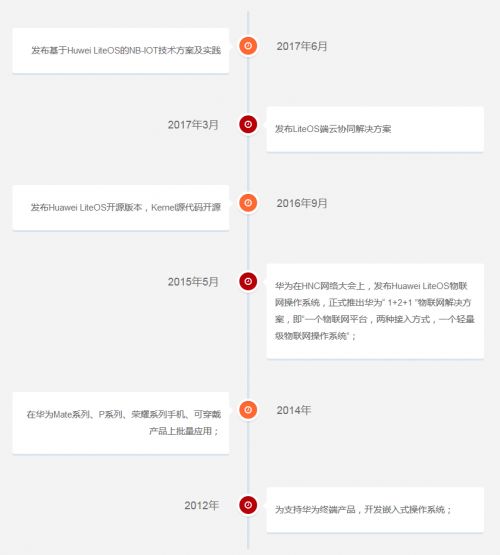
Official sources show that since its release in the open-source community, Huawei LiteOS has enabled partners from multiple dimensions around the NB-IoT market in terms of technology, ecology, solutions, and commercial support, building an open-source IoT ecosystem. It has now aggregated over 30 MCU and solution partners to jointly launch a batch of open-source development kits and industry solutions, helping many industry customers quickly launch IoT terminals and services, covering various industries such as metering, parking, street lights, environmental protection, shared bicycles, and logistics, accelerating the development of the IoT industry and the digital transformation of industries.
NB-IoT technology is the networking technology that Huawei promoted earliest, and it seems that Huawei has thrived in building an ecosystem around this technology. According to an article from “Communication World” published in January this year, Huawei LiteOS has supported the cumulative shipment of over 50 million units of Huawei’s internal products. Since the fourth quarter of 2016, the shipment of smart home products using Huawei LiteOS, such as smart peepholes, smart doorbells, and security cameras, has exceeded 100,000 units.
AliOS
In an interview with reporters from Nonferrous Network, Xie Linfeng, chief architect of the IoT operating system from Alibaba Cloud IoT Division, introduced its product: “Unlike many products on the market that are derived from traditional RTOS but labeled as ‘IoT operating systems’ or open-source projects, AliOS Things is an operating system tailored for modern IoT applications. In addition to providing a highly scalable, real-time, and secure kernel, AliOS Things also natively provides many high-level capabilities urgently needed in the IoT era, including cloud-integrated device and application management, security system and application upgrades, high-precision positioning, sensor data clouding and local analysis, dynamic security vulnerability diagnosis, as well as a one-stop application development environment including cloud deployment. For typical IoT scenarios, AliOS Things has been end-to-end optimized, ensuring that applications based on AliOS Things achieve the best performance and lowest resource consumption for the same functional set.”
Regarding its development history, the official website only has three simple lines:
On September 28, 2017, Alibaba announced the upgrade of its operating system strategy and released the new AliOS brand and slogan: Driving Intelligent Connectivity.
On October 13, 2017, AliOS reached a strategic cooperation with Zebra Network and Dongfeng Motor to promote the intelligentization of future vehicles, with the first model to be launched by Dongfeng Citroën.
On October 20, 2017, the lightweight IoT embedded operating system AliOS Things under the AliOS family was officially open-sourced.
As for its advantages, it has inherent advantages in cloud computing for enterprise applications. However, there are also many complaints, with developers writing in forums: “Ali’s RTOS references several implementations of uCOS, which will be AliOS’s biggest criticism. As one of the most important network protocol stacks for IoT systems, they have not achieved originality, using the well-known LwIP, while the file system also uses the open-source FatFS. If this is the case, how can they confidently compete with ARM’s mbed OS? The gap is quite large.” Although Alibaba is also actively collaborating with ST to layout its ecosystem, creating an environment that allows developers to quickly adapt and continuously maintain kernel upgrades and issues is also a challenge for Alibaba.
FreeRTOS
As a lightweight operating system, FreeRTOS provides functions including task management, time management, semaphores, message queues, memory management, and logging, which can basically meet the needs of smaller systems.
FreeRTOS has many applications, adopts a Linux open-source approach, has a good ecosystem, and is widely accepted. In every embedded operating system market research report by EEtime magazine, FreeRTOS ranks among the top.
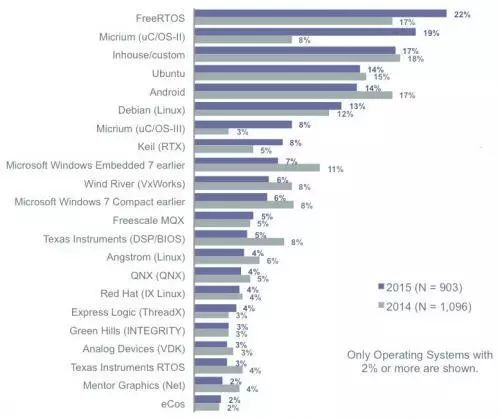
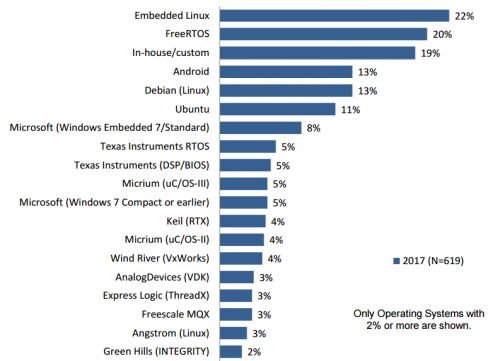
A big news at the end of last year was that the author of FreeRTOS joined Amazon AWS as chief engineer, officially launching Amazon FreeRTOS. Since Amazon FreeRTOS is based on the FreeRTOS kernel, embedded developers find it very easy to understand, and the development environment itself has not changed much. Several IoT chip companies like NXP and ST have already ported end-to-end integration, so acceptance is relatively high.
RT-Thread
RT-Thread was born in 2006, developed independently by Chinese developers. It is a technology platform that integrates the RTOS kernel, middleware components, and developer community, led by Mr. Xiong Puxiang and developed with the power of the open-source community. It has become the most mature and stable open-source embedded operating system in China, with the largest installed base. RT-Thread is also a rich component platform, easy to develop, highly extensible, and highly secure IoT OS. Shanghai Ruisi Technology is the service company behind RT-Thread, responsible for its maintenance, operation, and core component development.
Zou Cheng, COO of Ruisi Technology, mentioned in an interview with reporters from Nonferrous Network the characteristics of RT-Thread: “It occupies very little resources, with a minimum resource usage of 1.2KB RAM and 2.5KB flash; it has excellent real-time performance, with an interrupt response time of less than 1us; it supports many chips, with over 30 mainstream chips; and it has established a good initial software ecosystem, with the number of software packages exceeding 50.”
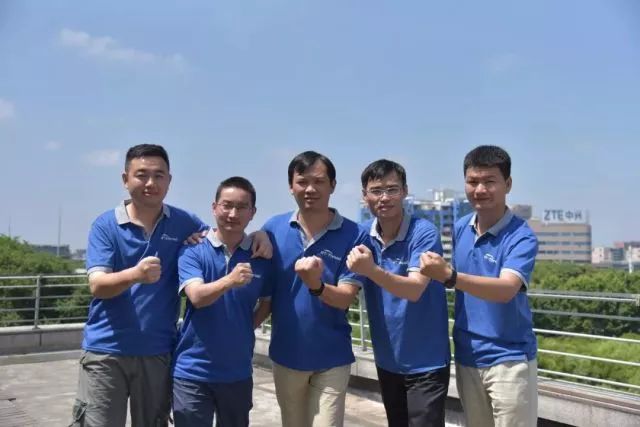
From left to right: Wu Yangyong, Qiu Yi, in the middle: Xiong Puxiang, second from the right: Zou Cheng, far right: Zhu Tianlong
At the same time, Zou Cheng also stated: “As an OS platform, ecological construction is a very time-consuming task, and the urgency of time is the biggest bottleneck we face. Of course, the relative lack of documentation and books, and the relatively small installed base compared to FreeRTOS are also challenges we have to face.”
Future
Last year, He stated in an interview with the media: “In the end, only a few operating systems will remain.” In the fierce competition among many products, what qualities are key to IoT operating systems? He summarized six key characteristics.
Ability to manage objects: From the perspective of embedded systems, “objects” are individual embedded computing devices (or deep embedded systems) that send and receive information on the network, such as smart sensors in homes or industrial sites. A common consensus in embedded system design today is to reduce power consumption, and a common method is to execute the system as quickly as possible and then immediately enter sleep mode. Current processor core architectures can consume almost no power in low-performance states.
Scalable and extensible architecture: As the price of 32-bit MCUs decreases, and Linux cannot support MCUs without MMUs, RTOS naturally becomes the first choice for IoT OS running on MCUs, as software running based on RTOS design is more flexible and extensible in these systems.
Ubiquitous Internet functionality: Supports commonly used wireless and wired communication functions for IoT, such as wireless communication functions supporting public networks like GPRS/3G/HSPA/4G, and also supports near-field communication functions like ZigBee/NFC/RFID/WiFi/Bluetooth, as well as wired network functions like Ethernet/CAN/USB, and the widely concerned narrowband communication technologies NB-IoT and LoRa. Protocols must be able to convert between these different physical and link layer interfaces, allowing data packets obtained from one protocol to be converted into another protocol for transmission, ultimately migrating to Internet protocols.
System security: A significant portion of IoT devices use MCUs and resource-limited microprocessors. Compared to large devices, these small devices are easier to protect and less susceptible to similar threats, making them more secure.
Cloud computing backend: The hallmark of IoT devices compared to traditional devices is that these devices will generate massive amounts of data. How to manage and process this data is a challenge facing IoT companies, and cloud computing is undoubtedly the most effective technological means to address this challenge. When choosing a cloud computing platform that supports IoT systems, the following technical factors should be considered:
1) Support for cloud computing and IoT protocols (Websocket, RESTful, MQTT, and CoAP, etc.).
2) Flexible standards and device management methods.
3) Support for secure remote firmware upgrades.
4) Capability for web/mobile application development.
5) Efficient and reliable data storage capabilities.
Advanced programming languages: The programming languages used for traditional embedded systems are mostly C and C++. Due to the characteristics of IoT devices, Internet programming technologies will enter IoT devices, and optimized Internet programming languages can run on low-power MCUs, such as Java and Python. It should be noted that Java always runs on top of the operating system, so your choice is not between C/C++ or Java, but both C/C++ and Java will be used.
In fact, for the IoT operating system to develop significantly, cooperation with academia and universities is also essential. After all, universities have a completely different perspective on technology from the business world; businesses are more inclined to generate immediate benefits, while universities pursue the dissection of technology, which is more conducive to student learning. In this regard, university participation will bring great benefits to the development of IoT operating systems.
Source: Nonferrous Network
